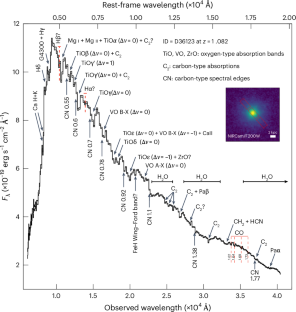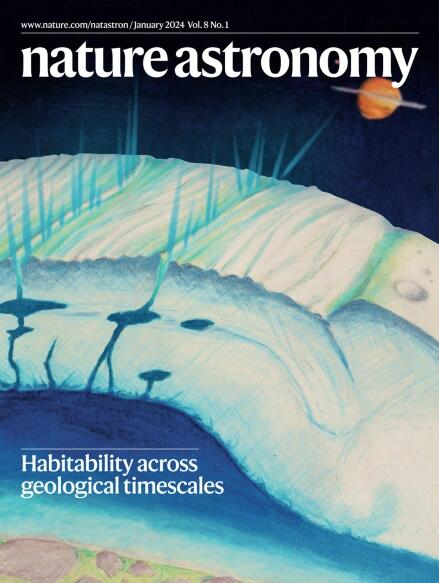Strong spectral features from asymptotic giant branch stars in distant quiescent galaxies
IF 12.9
1区 物理与天体物理
Q1 ASTRONOMY & ASTROPHYSICS
引用次数: 0
Abstract
Dating the ages and weighting the stellar populations in galaxies are essential steps when studying galaxy formation through cosmic times. Evolutionary population synthesis models with different input physics are used for this purpose. Moreover, the contribution from the thermally pulsing asymptotic giant branch (TP-AGB) stellar phase, which peaks for intermediate-age 0.6–2 Gyr systems, has been debated for decades. Here we report the detection of strong cool-star signatures in the rest-frame near-infrared spectra of three young (~1 Gyr), massive (~1010 M⊙) quiescent galaxies at large look-back time, z = 1–2, using JWST/NIRSpec. The coexistence of oxygen- and carbon-type absorption features, spectral edges and features from rare species, such as vanadium and possibly zirconium, reveal a strong contribution from TP-AGB stars. Population synthesis models with a significant TP-AGB contribution reproduce the observations better than those with a weak TP-AGB, which are commonly used. These findings call for revisions of published stellar population fitting results, as they point to populations with lower masses and younger ages and have further implications for cosmic dust production and chemical enrichment. New generations of improved models are needed, informed by these and future observations. Strong near-infrared spectral features from asymptotic giant branch stars are detected by JWST in the integrated light from distant quiescent galaxies, clarifying their contribution to galaxy spectra and population synthesis models.


来自遥远静止星系中渐近巨枝星的强光谱特征
对星系中恒星种群的年龄进行定年和加权是研究星系形成到宇宙时期的重要步骤。为此,我们使用了不同物理输入的演化种群合成模型。此外,热脉动渐变巨枝(TP-AGB)恒星阶段的贡献已经争论了几十年,该阶段在 0.6-2 Gyr 中龄系统中达到峰值。在这里,我们报告了利用 JWST/NIRSpec 在大回望时间 z = 1-2 时,在三个年轻(〜1 Gyr)、大质量(〜1010 M⊙)静止星系的静帧近红外光谱中探测到的强冷恒星特征。氧型和碳型吸收特征、光谱边缘和稀有物种(如钒和可能的锆)特征的共存揭示了TP-AGB恒星的强大贡献。与通常使用的弱TP-AGB模型相比,具有显著TP-AGB贡献的种群合成模型能更好地再现观测结果。这些发现要求对已发表的恒星种群拟合结果进行修订,因为它们指向质量较低和年龄较小的种群,并对宇宙尘埃的产生和化学富集有进一步的影响。我们需要根据这些发现和未来的观测结果改进新一代模型。
本文章由计算机程序翻译,如有差异,请以英文原文为准。
求助全文
约1分钟内获得全文
求助全文
来源期刊

Nature Astronomy
Physics and Astronomy-Astronomy and Astrophysics
CiteScore
19.50
自引率
2.80%
发文量
252
期刊介绍:
Nature Astronomy, the oldest science, has played a significant role in the history of Nature. Throughout the years, pioneering discoveries such as the first quasar, exoplanet, and understanding of spiral nebulae have been reported in the journal. With the introduction of Nature Astronomy, the field now receives expanded coverage, welcoming research in astronomy, astrophysics, and planetary science. The primary objective is to encourage closer collaboration among researchers in these related areas.
Similar to other journals under the Nature brand, Nature Astronomy boasts a devoted team of professional editors, ensuring fairness and rigorous peer-review processes. The journal maintains high standards in copy-editing and production, ensuring timely publication and editorial independence.
In addition to original research, Nature Astronomy publishes a wide range of content, including Comments, Reviews, News and Views, Features, and Correspondence. This diverse collection covers various disciplines within astronomy and includes contributions from a diverse range of voices.
 求助内容:
求助内容: 应助结果提醒方式:
应助结果提醒方式:


